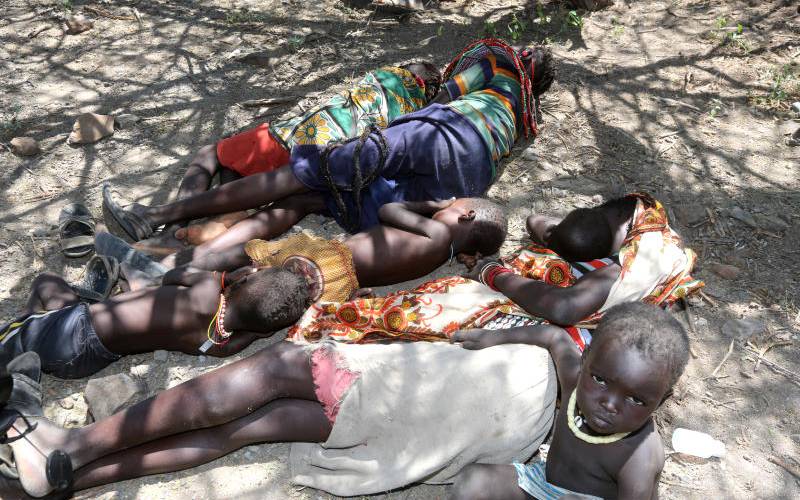
Shortage of funds is one of the reasons Kenya risks to lose the gains made in the fight against malaria, a ministry official has said.
As the country commemorated World Malaria Day on Thursday, Ministry of Health Head in Charge of Malaria Control Programme Dr Erjesa Waqo said the disease is still a threat.
This is despite the prevalence having reduced by 11 per cent. This is from 63 cases per every 1,000 persons in 2010 to 42.
Erjesa said while some counties have managed to reduce this prevalence further to even less than one case in every 1,000 it should not be assumed that the country has finally gotten rid of the disease.
"Kenya is still one of endemic countries. The gains we have made are so fragile and they need to be guarded," said Erjesa.
He said the Ministry aims to reduce the cases by 75 per cent by 2023 as per the newly unveiled Malaria strategy.
The strategy indicates that the Ministry needs Sh61 billion to finance the Malaria activities.
However, the total amount available is Sh37 billion leaving a gap of Should 24 billion.
"We expect to fill this gap from local funding and resources from partners," said Health Chief Administrative Secretary Dr Rashid Aman.
A big chunk of the Sh61 billion (about sh41 billion) will go towards prevention measures such as insecticides and treatment nets.
In the last four years, Dr Aman said the government through its partners has distributed 18 million treated nets.
He added that over 90 per cent of public hospitals are well equipped to diagnose and treat malaria.
But despite these efforts, Aman said 70 per cent of the Kenyan population is still at risk of malaria, with expectant mothers and children under five years being the most vulnerable.
Dr Erjesa said while the government has done all possible to ensure diagnostic kits and drugs are available, the general status of the country's health system still leaves alot of room for malaria to thrive.
"We may get all the commodities and diagnostics but if we do not improve our health system, we are still at risk. As a country we are not doing badly, but we need more invest in our health system," said Waqo.
As of July 2018 Kenya had 10,483 health facilities across the country as documented in the Kenya Malaria Strategy 2019-2023.
"There are, however, large disparities in the distribution of health facilities across the counties and disconnect between the level of health infrastructure development and provision of other requisite inputs such as human resources," reads the strategy in part.
Counties around the coast, highlands and lake regions are the most affected with rampant malaria cases with some recrding 200 cases in every 1,000.
Kisumu, Migori, Busia, Bungoma, Homabay, Kwale, Kakamega, and Siaya are among the counties that have high prevalence of malaria above eight per cent, which is the national prevalence.
In Siaya, where the World Malaria Day was held the prevalence stands at 27 per cent from 38 per cent in 2010.
Siaya County Commissioner Michael Oletialal said one of the challenges in eradicating malaria in the area is that residents are yet to adopt prevention measures.
"It is not a surprise to find homesteads where people fence their gardens using the treated nets. But we also have noticed that some malaria cases are missed due to existence of quack lab technicians," said Oletialal.
Nyandarua, Laikipia, Kirinyaga, and Nyeri are among the counties which record les kis than one case in every 1,000.
All the above counties, said Health CAS Dr Aman will be used in the upcoming pilot programme to introduce malaria vaccine.
According to Kenya National Bureau of Statistics, at least 16,000 people died from malaria in 2016.
This was a drop compared to 20,691 deaths in 2015.
However the Ministry in the Malaria strategy states that there is no reliable data on mortality.
"The malaria mortality data were not reliable enough to judge the impact made in malaria control during this period because it the challenge with classifying and determining cause of death in the broader Kenya healh system," reads the ministry document.
 The Standard Group Plc is a multi-media organization with investments in media platforms spanning newspaper print
operations, television, radio broadcasting, digital and online services. The Standard Group is recognized as a
leading multi-media house in Kenya with a key influence in matters of national and international interest.
The Standard Group Plc is a multi-media organization with investments in media platforms spanning newspaper print
operations, television, radio broadcasting, digital and online services. The Standard Group is recognized as a
leading multi-media house in Kenya with a key influence in matters of national and international interest.











